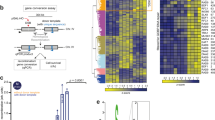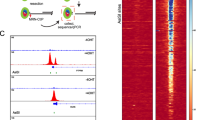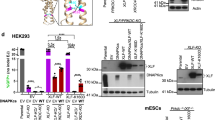Abstract
If not properly processed and repaired, DNA double-strand breaks (DSBs) can give rise to deleterious chromosome rearrangements, which could ultimately lead to the tumour phenotype1,2. DSB ends are resected in a 5′ to 3′ fashion in cells, to yield single-stranded DNA (ssDNA) for the recruitment of factors critical for DNA damage checkpoint activation and repair by homologous recombination2. The resection process involves redundant pathways consisting of nucleases, DNA helicases and associated proteins3. Being guided by recent genetic studies4,5,6, we have reconstituted the first eukaryotic ATP-dependent DNA end-resection machinery comprising the Saccharomyces cerevisiae Mre11–Rad50–Xrs2 (MRX) complex, the Sgs1–Top3–Rmi1 complex, Dna2 protein and the heterotrimeric ssDNA-binding protein RPA. Here we show that DNA strand separation during end resection is mediated by the Sgs1 helicase function, in a manner that is enhanced by Top3–Rmi1 and MRX. In congruence with genetic observations6, although the Dna2 nuclease activity is critical for resection, the Mre11 nuclease activity is dispensable. By examining the top3 Y356F allele and its encoded protein, we provide evidence that the topoisomerase activity of Top3, although critical for the suppression of crossover recombination2,7, is not needed for resection either in cells or in the reconstituted system. Our results also unveil a multifaceted role of RPA, in the sequestration of ssDNA generated by DNA unwinding, enhancement of 5′ strand incision, and protection of the 3′ strand. Our reconstituted system should serve as a useful model for delineating the mechanistic intricacy of the DNA break resection process in eukaryotes.
This is a preview of subscription content, access via your institution
Access options
Subscribe to this journal
Receive 51 print issues and online access
$199.00 per year
only $3.90 per issue
Buy this article
- Purchase on Springer Link
- Instant access to full article PDF
Prices may be subject to local taxes which are calculated during checkout




Similar content being viewed by others
References
Sung, P. & Klein, H. Mechanism of homologous recombination: mediators and helicases take on regulatory functions. Nature Rev. Mol. Cell Biol. 7, 739–750 (2006)
Krogh, B. O. & Symington, L. S. Recombination proteins in yeast. Annu. Rev. Genet. 38, 233–271 (2004)
Mimitou, E. P. & Symington, L. S. Nucleases and helicases take center stage in homologous recombination. Trends Biochem. Sci. 34, 264–272 (2009)
Gravel, S., Chapman, J. R., Magill, C. & Jackson, S. P. DNA helicases Sgs1 and BLM promote DNA double-strand break resection. Genes Dev. 22, 2767–2772 (2008)
Mimitou, E. P. & Symington, L. S. Sae2, Exo1 and Sgs1 collaborate in DNA double-strand break processing. Nature 455, 770–774 (2008)
Zhu, Z., Chung, W. H., Shim, E. Y., Lee, S. E. & Ira, G. Sgs1 helicase and two nucleases Dna2 and Exo1 resect DNA double-strand break ends. Cell 134, 981–994 (2008)
Ira, G., Malkova, A., Liberi, G., Foiani, M. & Haber, J. E. Srs2 and Sgs1-Top3 suppress crossovers during double-strand break repair in yeast. Cell 115, 401–411 (2003)
Zou, L. & Elledge, S. J. Sensing DNA damage through ATRIP recognition of RPA-ssDNA complexes. Science 300, 1542–1548 (2003)
Budd, M. E., Choe, W. C. & Campbell, J. L. DNA2 encodes a DNA helicase essential for replication of eukaryotic chromosomes. J. Biol. Chem. 270, 26766–26769 (1995)
Bae, S. H., Bae, K. H., Kim, J. A. & Seo, Y. S. RPA governs endonuclease switching during processing of Okazaki fragments in eukaryotes. Nature 412, 456–461 (2001)
Ivanov, E. L., Sugawara, N., White, C. I., Fabre, F. & Haber, J. E. Mutations in XRS2 and RAD50 delay but do not prevent mating-type switching in Saccharomyces cerevisiae . Mol. Cell. Biol. 14, 3414–3425 (1994)
Bae, S. H. & Seo, Y. S. Characterization of the enzymatic properties of the yeast Dna2 helicase/endonuclease suggests a new model for Okazaki fragment processing. J. Biol. Chem. 275, 38022–38031 (2000)
Trujillo, K. M. et al. Yeast Xrs2 binds DNA and helps target Rad50 and Mre11 to DNA ends. J. Biol. Chem. 278, 48957–48964 (2003)
Furuse, M. et al. Distinct roles of two separable in vitro activities of yeast Mre11 in mitotic and meiotic recombination. EMBO J. 17, 6412–6425 (1998)
Moreau, S., Ferguson, J. R. & Symington, L. S. The nuclease activity of Mre11 is required for meiosis but not for mating type switching, end joining, or telomere maintenance. Mol. Cell. Biol. 19, 556–566 (1999)
Bressan, D. A., Olivares, H. A., Nelms, B. E. & Petrini, J. H. Alteration of N-terminal phosphoesterase signature motifs inactivates Saccharomyces cerevisiae Mre11. Genetics 150, 591–600 (1998)
Paull, T. T. & Gellert, M. The 3′ to 5′ exonuclease activity of Mre11 facilitates repair of DNA double-strand breaks. Mol. Cell 1, 969–979 (1998)
Lu, J. et al. Human homologues of yeast helicase. Nature 383, 678–679 (1996)
Liu, Y., Kao, H. I. & Bambara, R. A. FLAP endonuclease 1: a central component of DNA metabolism. Annu. Rev. Biochem. 73, 589–615 (2004)
Budd, M. E. & Campbell, J. L. A yeast replicative helicase, Dna2 helicase, interacts with yeast FEN-1 nuclease in carrying out its essential function. Mol. Cell. Biol. 17, 2136–2142 (1997)
Chiolo, I. et al. Srs2 and Sgs1 DNA helicases associate with Mre11 in different subcomplexes following checkpoint activation and CDK1-mediated Srs2 phosphorylation. Mol. Cell. Biol. 25, 5738–5751 (2005)
Chen, L., Trujillo, K., Ramos, W., Sung, P. & Tomkinson, A. E. Promotion of Dnl4-catalyzed DNA end-joining by the Rad50/Mre11/Xrs2 and Hdf1/Hdf2 complexes. Mol. Cell 8, 1105–1115 (2001)
Chen, C. F. & Brill, S. J. Binding and activation of DNA topoisomerase III by the Rmi1 subunit. J. Biol. Chem. 282, 28971–28979 (2007)
Wu, L. & Hickson, I. D. The Bloom’s syndrome helicase suppresses crossing over during homologous recombination. Nature 426, 870–874 (2003)
Masuda-Sasa, T., Polaczek, P., Peng, X. P., Chen, L. & Campbell, J. L. Processing of G4 DNA by Dna2 helicase/nuclease and replication protein A (RPA) provides insights into the mechanism of Dna2/RPA substrate recognition. J. Biol. Chem. 283, 24359–24373 (2008)
Bae, K. H. et al. Bimodal interaction between replication-protein A and Dna2 is critical for Dna2 function both in vivo and in vitro . Nucleic Acids Res. 31, 3006–3015 (2003)
Cejka, P. et al. DNA end resection by Dna2–Sgs1–RPA and its stimulation by Top3–Rmi1 and Mre11–Rad50–Xrs2. Nature 10.1038/nature09355 (this issue)
Niu, H., Raynard, S. & Sung, P. Multiplicity of DNA end resection machineries in chromosome break repair. Genes Dev. 23, 1481–1486 (2009)
Zheng, L. et al. Human DNA2 is a mitochondrial nuclease/helicase for efficient processing of DNA replication and repair intermediates. Mol. Cell 32, 325–336 (2008)
Duxin, J. P. et al. Human Dna2 is a nuclear and mitochondrial DNA maintenance protein. Mol. Cell. Biol. 29, 4274–4282 (2009)
Acknowledgements
We thank J. Campbell, S. Brill and L. Symington for providing materials, X. Xue for the double Holliday junction substrate and S. Kowalczykowski for communicating results. This work was supported by grants from the US National Institutes of Health and by a postdoctoral fellowship from the Susan G. Komen for the Cure Foundation.
Author information
Authors and Affiliations
Contributions
H.Y.N, G.I. and P.S. designed the experiments and wrote the paper. H.Y.N., W.-H.C., Z.Z., Y.H.K., P.C., W.X.Z. and R.P. conducted the experiments. L.L. and D.L. provided key materials and technical expertise.
Corresponding authors
Ethics declarations
Competing interests
The authors declare no competing financial interests.
Supplementary information
Supplementary Information
The file contains Supplementary Methods, Supplementary Figures 1-12 with legends, a Supplementary Table and additional references. (PDF 4343 kb)
Rights and permissions
About this article
Cite this article
Niu, H., Chung, WH., Zhu, Z. et al. Mechanism of the ATP-dependent DNA end-resection machinery from Saccharomyces cerevisiae. Nature 467, 108–111 (2010). https://doi.org/10.1038/nature09318
Received:
Accepted:
Issue Date:
DOI: https://doi.org/10.1038/nature09318
This article is cited by
-
Hypersaline Lake Urmia: a potential hotspot for microbial genomic variation
Scientific Reports (2023)
-
Deciphering the mechanism of processive ssDNA digestion by the Dna2-RPA ensemble
Nature Communications (2022)
-
SAMHD1 deacetylation by SIRT1 promotes DNA end resection by facilitating DNA binding at double-strand breaks
Nature Communications (2022)
-
PRMT1 and PRMT5: on the road of homologous recombination and non-homologous end joining
Genome Instability & Disease (2022)
-
New insights into the mechanism of RPA in preserving genome stability
Genome Instability & Disease (2022)
Comments
By submitting a comment you agree to abide by our Terms and Community Guidelines. If you find something abusive or that does not comply with our terms or guidelines please flag it as inappropriate.



